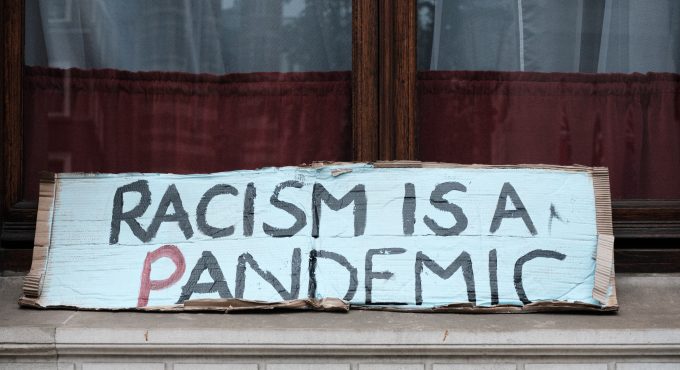From The Critical Race Initiative: In solidarity with our Asian and Asian American colleagues and friends

On Tuesday, a white man purchased a gun and within hours walked into a spa and shot and killed 8 people, 6 of them women of Asian descent. Countless media outlets have called this attack everything but what it is, including a Georgia police captain who attributed the mass shooter’s actions to him “having a really bad day.” We know it was a targeted racist and misogynistic act of domestic terrorism yet, it has not been officially labeled as such by police. It was also yet another blow to the Asian and Asian American community in the last few years.
Since the beginning of the pandemic, our Asian colleagues and neighbors have been consistently targeted with xenophobic and racist epithets, baseless and unjustified claims of responsibility for a global virus, and even physical harm. However, Asian and Asian American exclusion and racism are not new even though it is often overlooked and underestimated. In fact, some of the United States’ first immigration laws were directly targeted at Asian groups. A summary of these is below:
- 1875: U.S. Congress passed the Page Act of 1875. This act was designed to prevent unfree or “immoral” labor from entering into the U.S. from China, Japan, and other East Asian countries such as forced-labor, sex workers, and people who were incarcerated. The act targeted and was heavily enforced for Chinese women, which reinforced stereotypes and assumptions about their employment and sexuality. This act paved the way for future immigration policies that were even more exclusive.
- 1882: U.S. Congress passed the Chinese Exclusion Act. This act established an absolute 10-year halt on the immigration of skilled and unskilled Chinese laborers and placed new restrictions on Chinese immigrants who had already entered the country: If they left, they had to obtain new certification to re-enter. For the first time, federal law forbade the entry of an entire ethnic group, under the rationale that the presence of Chinese laborers would threaten certain labor markets.
- 1917: U.S. Congress overrode a presidential veto to pass the Immigration Act of 1917. It built upon the Chinese Exclusion Act and barred immigration of “undesirables” and anyone from the Asiatic Barred Zone or “any country not owned by the U.S. adjacent to the continent of Asia.” The act was also notable for its literacy test component: To be eligible for immigration to the U.S., anyone over the age of 16 had to prove they were capable of reading 30 to 40 words.
- 1924: The Immigration Act of 1924, also known as the Johnson-Reed Act, enacted a national origins quota on immigration. This system allowed visas to 2% of the total number of people of each nationality in the U.S. as reflected in the 1890 decennial census. Once again, it excluded Asian immigrants. Linking immigration eligibility to the definition of whiteness at the time, the act also included a provision that excluded anyone ineligible for citizenship on account of their race. These acts were signed into law to preserve the White Americanness of the United States.
- 1942: During World War II, Executive Order 9066 was signed by President Roosevelt, giving the U.S. military instruction to ban and relocate any person of Japanese ancestry, including those who were U.S. citizens, from a 60-mile wide coastal stretch along the Western seaboard. Thousands of Japanese Americans and immigrants were transported to government-run internment camps. The last internment camp was not closed until the end of 1945.
It is important to note that Tuesday’s attack was not only an attack on Asian and Asian Americans. It was an attack on Asian women specifically. Asian women have long experienced racist misogyny in the forms of sexual harassment, unwanted sexual advances, and racist fetishization. The United States’ legacy of sexual imperialism has contributed to perceptions of Asian massage parlors and stereotypes of Asian women who work in them which, in this case specifically, led to racialized and gendered violence. Additionally, Asian women continue to be portrayed as exotic and docile in films and in the media. This can contribute to Asian women experiencing violent crimes as they are depicted as easy to control, and submissive victims who will not fight back.
There are countless intersections of race, gender, class, immigrant status, sexuality, and other social identities that impact how communities experience violence. This week we have seen the dangerous consequences of white supremacy that the U.S. continues to grapple with. Anti-Blackness, anti-Asian racism, xenophobia, and misogyny are all connected and work together to serve white supremacy. We call on our colleagues to step up, speak out, and take action against the violence and issues faced by Asian Americans and Pacific Islanders. Furthermore, while our university is on Spring Break right now, we urge our colleagues to refrain from going about business as usual. Please recognize that people of color have been enduring the pandemic with additional and consistent challenges.
Click here for a list of resources to learn additional information and support AAPI folks.
For more information on the Critical Race Initiative, visit their website or connect with them on Twitter and Facebook.

Comments 1
Luke Ingamells
May 6, 2021very interesting